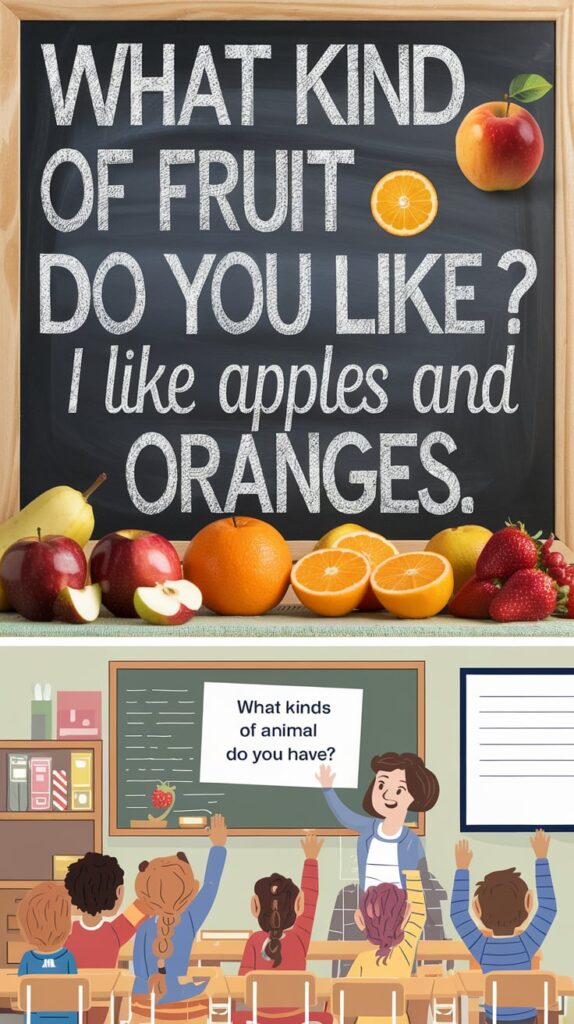the Differences
Navigating the intricacies of the English language can be challenging, especially when it comes to seemingly simple phrases like “what kind of” vs “what kinds of.”
These phrases often confuse many speakers and writers, leading to unclear communication. Understanding the differences between “what kind of” vs “what kinds of” is essential for effective expression.
This comprehensive guide will delve into the nuances of each phrase, providing usage examples, contextual understanding, common errors, and practical scenarios.
With a focus on “what kind of” vs “what kinds of,” we’ll explore how to use these phrases effectively in various contexts.
read more : Messege or Message – Grammar Beacon

What Kind of vs What Kinds of – Differences
At its core, the distinction between “what kind of” vs “what kinds of” is straightforward:
- “What kind of” refers to a single category or type of something.
- “What kinds of” indicates multiple categories or types.
Understanding this difference is crucial for effective communication. Choosing the correct phrase helps ensure that your questions elicit the right kind of responses, which is particularly important in discussions that involve specific preferences or categories.
Example Breakdown
To illustrate the differences, consider the following examples:
What kind of music do you listen to?”
Here, you’re asking for a singular type of music, such as jazz or rock.
“What kinds of books do you have in your library?”
This question seeks a variety of book types, like fiction, non-fiction, or mystery.
By focusing on singular versus plural, you can ensure clarity in your inquiries, enhancing the overall quality of your conversations.
Usage Examples
When you want to ask about preferences or types, your choice between “what kind of” vs“what kinds of” sets the stage for the expected answer. Using the right phrase helps guide the respondent to give the information you’re seeking.
What Kind of
Here are some additional examples that emphasize “what kind of”:
“What kind of food do you prefer?”
This invites a specific answer, like Italian or Mexican.
“What kind of job do you want?”
The expectation here is for a singular response, such as teacher or engineer.
Using “what kind of” effectively narrows down the scope of your question, encouraging precise answers that can lead to more meaningful discussions.

What Kinds of
Conversely, when you use “what kinds of,” you open the floor for multiple answers:
“What kinds of hobbies do you enjoy?”
This question encourages a broader response, such as painting, hiking, or playing music.
“What kinds of pets do you have?”
This prompts answers about various types of animals, like dogs, cats, or even fish.
By employing “what kinds of,” you foster a richer dialogue and allow for a more engaging exchange of ideas.
read more : Moment vs Momment – Grammar Beacon
Contextual Understanding
Understanding the context of your inquiry is vital. Consider the situation and what kind of information you’re seeking. Tailoring your questions based on context ensures that you obtain the most relevant information from your conversations.
Singular Queries
If you anticipate a singular response, opt for “what kind of.” For instance, if you’re discussing food preferences, saying:
- “What kind of dessert do you like?”
will prompt someone to answer with a specific type, such as cake or ice cream. This approach is particularly effective in situations where you want detailed information about a specific category.
Plural Queries
In scenarios where you expect multiple responses, use “what kinds of.” For example:
- “What kinds of drinks do you enjoy?”
This invites a range of answers, such as soda, tea, or coffee. Using “what kinds of” encourages a more expansive discussion, allowing for the inclusion of diverse perspectives.
By tailoring your questions to the context, you can encourage more informative conversations that lead to deeper understanding.
Common Errors and Misconceptions
Many people mistakenly use “what kinds of” when they should use “what kind of,” leading to confusion. Here are some common errors to avoid:
Incorrect Usage
“What kinds of music do you listen to?”
If someone primarily listens to one genre, a better phrasing would be:
“What kind of music do you listen to?”
“What kinds of movie do you like?”
This should be corrected to:
“What kind of movie do you like?”
Clarifying Confusion
These examples underscore the importance of choosing the right phrase. Aiming for clarity in your questions helps avoid misunderstandings and ensures the answers you receive are relevant and insightful.

31 Key Points for What Kind of vs What Kinds of
To deepen your understanding of “what kind of” vs “what kinds of,” consider the following key points:
- Use “what kind of” for singular inquiries.
- Reserve “what kinds of” for plural inquiries.
- Pay attention to the subject of your question.
- Be mindful of context.
- Avoid unnecessary confusion by choosing the right phrase.
- Consider the respondent’s likely answer.
- Reflect on the nature of the nouns involved.
- Use collective nouns with care.
- Recognize the audience’s understanding.
- Engage in practice with both phrases.
- Read more to internalize the differences.
- Experiment in conversations.
- Use examples to clarify your points.
- Encourage feedback on your usage.
- Share your understanding with others.
- Keep sentences concise.
- Focus on clarity over complexity.
- Explore variations in tone.
- Listen to how others use the phrases.
- Challenge yourself with writing exercises.
- Pay attention to grammar rules.
- Study related phrases for better comprehension.
- Embrace feedback and adjust.
- Use quizzes to test your knowledge.
- Engage with educational resources.
- Observe the language in context.
- Utilize language tools.
- Connect with others interested in language.
- Seek out additional practice scenarios.
- Keep learning to refine your skills.
- Review and reflect on your progress.
These points will help reinforce your understanding of the phrases and improve your overall communication skills.
Singular Nouns with Multiple Attributes
One interesting aspect of English is that singular nouns can possess multiple attributes. For example:
- “What kind of car do you drive?”
- This question seeks a specific category of car, such as sedan or SUV.
However, if you want to inquire about various types of cars, you would ask:
- “What kinds of cars do you like?”
This opens up the conversation to multiple answers, inviting responses that might include electric, sports, or luxury cars.
Collective Nouns
When working with collective nouns, your choice between “kind” and “kinds” remains essential. Collective nouns refer to groups, and how you phrase your question can impact clarity. For instance:
- “What kind of team do you support?”
- This focuses on a specific type of team, such as a football team.
In contrast, if you want information about various teams, you would say:
- “What kinds of teams are in the league?”
This invites answers that cover multiple teams, prompting a richer discussion and a more engaging conversation.
Plural Nouns with Singular Classification
At times, you may encounter scenarios where plural nouns are classified under a singular category. For example:
- “What kind of plants do you grow?”
- This question expects a specific category, such as herbs or flowers.
But when you want to ask about different varieties, you could say:
- “What kinds of plants do well in your area?”
This encourages a response that reflects various types, such as succulents, ferns, or vegetables.
read more : Plural of Syllabus? – Grammar Beacon

Context and Intended Meaning
Choosing the correct phrase often hinges on your context and intended meaning. When asking about preferences, keep in mind how the responses will shape your question:
If someone prefers a particular genre of music, you would ask:
“What kind of music do you enjoy?”
If they enjoy various types, you could say:
“What kinds of movies do you like?”
Your phrasing significantly influences the type of responses you receive and shapes the direction of your conversation.
Examples with What Kinds of
To reinforce the use of “what kinds of,” consider these examples:
“What kinds of fruits do you like?”
This invites a variety of answers, such as apples, bananas, or mangoes.
“What kinds of exercises do you prefer?”
This question encourages responses that include various activities, like running, swimming, or yoga.
These examples illustrate how “what kinds of” broadens the scope of the conversation, making it more engaging.
Examples with What Kind of
Now, let
’s look at examples featuring “what kind of”:
“What kind of sports do you play?”
This typically leads to a singular answer, such as basketball or soccer.
“What kind of job do you have?”
The expected answer here might be a specific role, like nurse or writer.
These examples reinforce the expectation of a singular response with “what kind of.”
read more : Arised or Arose: What’s the Correct Past Tense of Arise? – Grammar Beacon
The Role of Tone and Delivery
When asking questions using “what kind of” vs “what kinds of,” the tone and delivery can also affect how your message is received. A conversational tone can make your inquiries feel more engaging, encouraging open dialogue.
Conversational Tone
Adopting a conversational tone can help make your questions feel more approachable. For instance:
- Instead of simply asking, “What kinds of music do you listen to?”
- You might say, “I’d love to know—what kinds of music do you listen to?”
This subtle change invites a more enthusiastic response and sets a friendly tone for the conversation.
Adjusting for Formality
In more formal settings, your approach may need to be adjusted. For example, during a job interview, you could frame it like this:
- “Could you please share what kind of projects you typically handle?”
This maintains professionalism while still being direct, ensuring your inquiry is appropriate for the context.
Cultural Variations in Usage
Cultural differences can also play a role in how these phrases are used. In some cultures, the distinction may be more pronounced, while in others, it may be less clear.
Being aware of these differences can enhance cross-cultural communication and improve your interactions with people from diverse backgrounds.
Understanding Regional Dialects
In some regions, people might use “what kinds of” more liberally, even in singular contexts. For example:
- In casual conversations, someone might say, “What kinds of pizza do you like?” even if they are only asking about one person’s preference.
Recognizing these variations can help you adapt your language to fit different contexts and improve your communication skills.
Practical Applications
Understanding the distinction between “what kind of” and “what kinds of” isn’t just an academic exercise; it has real-world applications. Here are some practical scenarios where you can apply this knowledge effectively.
Job Interviews
During a job interview, clarity is key. For instance, if you’re discussing your experience, you might say:
- “What kind of skills do you think are essential for this position?”
This approach focuses on specific skills, prompting a focused discussion that helps you demonstrate your qualifications and understanding of the role.
Social Gatherings
At social events, you might engage in conversations about interests:
- “What kinds of movies do you enjoy watching?”
This invites a variety of responses, making the conversation lively and dynamic, while allowing you to discover common interests.

Educational Settings
In educational settings, teachers can use these phrases to assess student understanding. For instance:
- “What kind of projects do you enjoy the most in class?”
- This helps gauge student preferences, while also allowing for follow-up questions about specific projects and activities.
Networking Events
When networking, using these phrases can foster deeper connections. You might ask:
- “What kinds of challenges do you face in your industry?”
This encourages open dialogue and sharing of experiences, enhancing your networking efforts and allowing for collaborative problem-solving.
Enhancing Written Communication
Understanding the difference between “what kind of” vs “what kinds of” also benefits written communication. Clarity in writing is just as important as clarity in speech. Here’s how to apply these phrases in written contexts effectively.
Crafting Clear Questions
When writing emails or reports, using these phrases correctly can enhance clarity. For example, you might write:
- “I would like to know what kind of support you need for this project.”
This specifies the type of support being requested.
Conversely, if you’re looking for broader input, you could say:
- “What kinds of strategies do you think would be effective?”
This encourages a range of responses and invites collaborative thinking.
Formal vs. Informal Writing
In formal writing, such as academic papers or professional correspondence, precision is crucial. Using “what kind of” and “what kinds of” correctly ensures your writing conveys the intended meaning.
- In a research paper, you might state:
- “This study examines what kind of factors influence consumer behavior.”
In contrast, if you are discussing various influences, you could say:
- “The survey sought to identify what kinds of factors impact purchasing decisions.”
Maintaining clarity in both formal and informal writing helps your audience understand your message effectively.
Developing Language Skills
As you become more comfortable with “what kind of” and “what kinds of,” you can also develop your overall language skills. Here are some strategies to enhance your proficiency.
Practice Conversations
Engaging in practice conversations can help solidify your understanding. Partner with someone to ask questions using both phrases. For example:
- “What kind of art do you appreciate?”
- “What kinds of artists inspire you?”
This kind of practice will help reinforce the differences between the two phrases in real-life contexts.
Journaling
Consider keeping a journal where you reflect on daily conversations or observations. Write entries that incorporate both “what kind of” and “what kinds of.” For example:
- “Today, I learned about what kinds of books people enjoy reading.”
- “I also discovered what kind of movies my friends recommend.”
Journaling helps you internalize language patterns and improves your writing skills.
Educational Resources
Utilize educational resources such as grammar guides, online courses, or language apps to further your understanding. Many platforms provide exercises focused on common phrases and their usage, helping you practice.
Real-World Scenarios
Here are a few real-world scenarios to illustrate how you can effectively use “what kind of” and “what kinds of” in various situations.
Scenario 1: A Cooking Class
Imagine you’re in a cooking class. The instructor might ask:
- “What kind of cuisine do you want to learn today?”
This question is designed to determine a specific type of cuisine, allowing for focused instruction.
Later, during a discussion, a fellow student might ask:
- “What kinds of dishes do you like to cook at home?”
This encourages a range of responses and can lead to a lively discussion about different cooking styles and preferences.
Scenario 2: Networking Event
At a networking event, you might engage someone in conversation:
- “What kind of projects are you currently working on?”
This focuses the conversation on specific projects, allowing for detailed discussions about the individual’s work.
If the conversation shifts to challenges in the industry, you could ask:
- “What kinds of trends are you noticing in your field?”
This broadens the conversation, inviting insights and fostering a deeper dialogue about industry changes.
Scenario 3: Book Club Meeting
During a book club meeting, a member might ask:
- “What kind of themes resonate with you in literature?”
This question seeks specific themes, like love or betrayal.
Then, when discussing reading preferences, another member might inquire:
- “What kinds of genres do you enjoy?”
This encourages responses that encompass various genres, such as mystery, fantasy, or biography.
Conclusion
In summary, understanding the difference between “what kind of” vs “what kinds of” is crucial for effective communication. This distinction helps you convey your intended meaning clearly and ensures that your inquiries lead to relevant responses.
By using these phrases correctly, you can enhance your interactions and foster more informative discussions.
Always consider the context and the expected type of response. Practicing these distinctions will improve your language skills and enrich your conversations.
The next time you engage in dialogue, remember the importance of these phrases, and you’ll find your communication becoming more precise and engaging.
Keep exploring the depths of the English language. The more you practice and understand, the more confident you’ll become in using these subtle yet significant differences. Happy communicating!

James Logan is a seasoned blogger and language enthusiast behind Grammar Beacon. With years of experience in grammar and writing, James shares his expertise through insightful and engaging content. His passion for clear communication and linguistic precision shines in every post, making complex grammar concepts accessible and enjoyable for readers. Follow James for expert advice and tips to refine your writing skills.







